3 Reasons To Pink Eye
1. It’s a nice break from giving the stink eye. Gotta mix things up, you know?
2. You can use it to repel awkward interactions – “Don’t come near, I’m CONTAGIOUS!”
3. Sorry, that’s all I’ve got. Who actually loves pink eye???
Fortunately, there are several natural remedies and salt water is one of them.
For pink eye out there that mamas swear by. Today I’m going to share them with you, along with studies I’ve found related each remedy. But first, let’s ask one very important question . . .
Is It Viral, Bacterial, or An Allergy?
VIRAL PINK EYE IS . . .
SALT WATER WASH- a Natural Remedy For Pink Eye
Because pink eye can be highly contagious, it is usually recommended that individuals treat both eyes even if only one has symptoms.

Saline (salt water) eye drops are often recommended for pink eye. Some store bought brands contain lubricants and other medications for various conditions, but you can make a simple solution at home. Kathryn Darden, a Rodan + Fields Dermatologists consultant, explains how to use a salt water wash:
“Distilled water is recommended since tap water can contain chemicals and impurities, but many people use plain tap water. Boil one cup of water with one half teaspoon (up to one teaspoon) of salt and let the liquid cool completely before using.
Use an eye cup or an eye dropper to rinse the eye with the cooled salt solution. The solution can be used as an eye rinse and also as a nasal solution for sinus and allergy issues.
Rinse the affected eye several times a day. After rinsing, a gentle eye cream can help soothe the delicate skin of the eyelids but should be kept out of the eyes to avoid further irritation.” (source) According to Kathryn, you should discard the solution after two days and make a new one to avoid bacterial contamination. I personally would probably make a new batch each day.
Comfort Measures
WARM OR COLD COMPRESS
“To reduce pain and to remove the discharge of bacterial or viral pinkeye, use a cold or warm compress on the eyes. Make sure to use a different washcloth for each eye to prevent spreading any infection. And use clean washcloths each time. Clean the eye from drainage by wiping from the inside to the outside of the eye area.”
Pink Eye Prevention
Recurring pink eye infections are associated with vitamins A and B (especially B2) deficiencies, so it may be worth exploring supplementation if infections continue to occur. Cod liver oil is a source of naturally occurring vitamin A.
When To See A Doctor
According to the CDC, “Most cases of pink eye are mild and get better without treatment. However, some forms are more severe. Severe cases need to be looked at by a health care provider and may require specific treatment and close follow-up. If you have pink eye, you should see your health care provider if you have—
The CDC also recommends that all babies with pink eye symptoms be seen by a health care provider.

